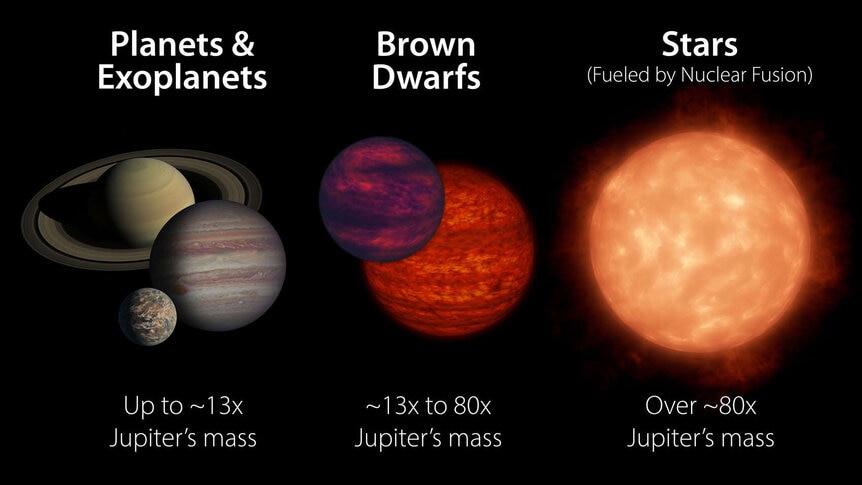Create a free profile to get unlimited access to exclusive videos, sweepstakes, and more!
An ancient space object is fast, faint, and there may be billions more like it

A very odd object has been found zipping through the galaxy on a path relatively near to the Sun, and while nothing quite like it has ever been seen before, it may be the first of many such old, cold things prevalent in the Milky Way.
The object is called WISEA J153429.75−104303.3 (WISE is the Wide-field Infrared Survey Explorer space observatory, and the numbers are its coordinates on the sky; let’s call it WISE 1534 for short). Its discovery is a story all by itself: It was found by citizen scientist Dan Caselden, who wrote his own software to go through WISE data. He was hunting for brown dwarfs, objects that are more massive than planets but less massive than stars.
Brown dwarfs were only discovered for the first time in the 1990s, after being theorized to exist for decades. They are extremely faint at visible light wavelengths, and but glow feebly in infrared light due to their own internal heat leftover from their formation. Because of this, the ones we tend to find are close by and relatively young; if they’re too far away or too old they’re too faint to spot.
Caselden wrote software that removed stationary objects like stars in images. Because the brown dwarfs we can see tend to be close by, they move across the sky over time due to both the Earth’s motion around the Sun and the brown dwarfs’ own motions through space. He was looking at another brown dwarf in the data when he noticed an extremely faint blip in the images that appeared to be moving very rapidly with time.
The software didn’t ping it as a brown dwarf because it didn’t match the color profile expected of such an object. In other words, he discovered it by accident (and in fact the object is nicknamed The Accident).
Once alerted, a team of astronomers started digging deeper. They observed it with one of the huge twin Keck 10-meter infrared telescopes, but it was so faint it couldn’t be seen. They were able to find it in archived data from Spitzer Space Telescope, however, and got images of it using an infrared filter on the Hubble Space Telescope’s Wide Field Camera 3.
From this they were able to get a parallax for the object, giving it a distance from Earth of just 53 light years — pretty close. But that meant it was incredibly dim, which is weird.
Weirder yet, the colors really were strange. It’s extremely red, meaning it’s brighter at longer infrared wavelengths than most brown dwarfs. But there’s more: In objects as cool as WISE 1534 you’d expect to see lots of methane, a very common molecule made of carbon and hydrogen, seen in many in such objects. Methane absorbs a specific color of infrared light, but the astronomers were surprised to see that the object was actually relatively bright at that wavelength. That means there was no methane in WISE 1524 to absorb that light. How could that be?
This strongly implies this brown dwarf is extremely old. We see lots of objects like it with methane… now. But back when the Universe was young it was mostly hydrogen and helium. Massive stars converted those elements into heavier ones like carbon in their cores, exploded, and seeded nearby gas clouds with them. These then collapsed to form new stars that then already had these heavier elements embedded. But stars that formed before that time are deficient in them.
The lack of methane in WISE 1534 means it lacks carbon, and that in turn implies it’s ancient. Like really ancient, perhaps more than 10 billion years old. The median age of brown dwarfs found is about half that, making this one of the oldest brown dwarfs known.
Also supporting this is that it’s positively screaming through space relative to the Sun at over 200 kilometers per second. As stars orbit the galaxy, they encounter other stars that can accelerate them gravitationally. A star that’s very old will have had many such encounters and will orbit the galaxy faster. WISE 1534’s rapid speed therefore also implies it’s very old.
How common are objects like WISE 1534? We expect the galaxy made a lot of them back in the day, but they’re extremely faint and hard to detect now. Worse, because its colors are so weird (so it gets overlooked by software searching for brown dwarfs with more normal colors), this implies there may be a lot more of these objects out there we’re missing.
But the fact that one was found so close to the Sun strongly implies they’re common. The galaxy is 120,000 light years across. If only one of these objects existed it would be truly bizarre to have found it so close to us; the odds of that are infinitesimal. If there are billions of them then it makes more sense.
So WISE 1534 may in fact be the first of billions of its kind ever seen. Finding more will be tough, though. Getting more information on WISE 1534 is hard, too, since it’s too faint to get spectra for it (breaking its light up into thousands of individual colors, allowing characteristics like mass, composition, temperature, and more to be measured). James Webb Space Telescope should be able to do it, and that is due to launch later this year.
We may know a lot more about this strange, old, cold object barreling through the galaxy soon enough. Hopefully too we can find lots more.





























